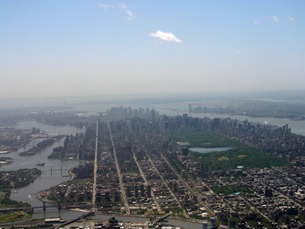New York’s Greater, Greener Grid
by Alec Applebaum, NEW YORK TIMES, April 18, 2011
 MANHATTAN’S street grid, which turned 200 years old last month, has long been an easy target for urban romantics. They love to point out how its relentless logic — most blocks are a precise 200 feet by 600 feet — imposed a soulless Cartesian order on a once-lush coastal island, trampling nature and leading to two centuries of real-estate mania.
MANHATTAN’S street grid, which turned 200 years old last month, has long been an easy target for urban romantics. They love to point out how its relentless logic — most blocks are a precise 200 feet by 600 feet — imposed a soulless Cartesian order on a once-lush coastal island, trampling nature and leading to two centuries of real-estate mania.
But the Commissioners’ Plan, as the grid is formally called, in fact made prescient and wise use of the city’s natural environment — a fact that was lost on later generations of city planners. As the Bloomberg administration looks for cost-effective ways to make New York more resilient to the effects of climate change, it should look back to the grid’s genius and find new ways to help, rather than stifle, the constructive role nature can play in shaping the city.
Manhattan’s natural resources were a major reason that Native Americans, and then the Dutch, settled here: the soil is easy to dig, the drinking water is excellent and the soft ocean breezes and startling vistas make it a pleasant place to live.
The early 19th-century planners who created the grid knew how to make the most of these attributes. They laid out the grid so that the sun sets precisely in line with east-west streets several times a year. The short north-south blocks mean more streets lead to the rivers, allowing floodwaters to recede easily and drawing people to the waterfront. The plan guided raucous commerce along the route of an old canal and enticed future developers with the promise of sites on hills with enviable views north.
Within the grid they placed an engineering marvel, the Croton Aqueduct and Reservoir; the latter is gone, but the aqueduct still delivers clean and tasty drinking water from upstate. Perhaps their wisest move was to conserve 843 prime acres as a Central Park to provide “the lungs of the city.”
But rather than continue working with nature as a template, subsequent generations fought against the city’s environment. Planners wrangled natural streams into (eventually) rusty pipe systems. The city dredged so many swamps and poured so much asphalt that the ground has become unable to handle heavy downpours. When it rains a lot — as it increasingly has in recent years — rainwater flows into the same pipes that carry sewage. When those pipes overflow, the combined liquid dumps into the rivers. That’s not how nature would manage things. [Read rest of article}


